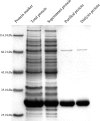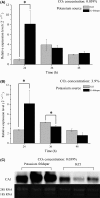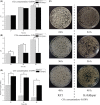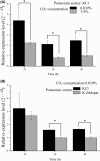The selective expression of carbonic anhydrase genes of Aspergillus nidulans in response to changes in mineral nutrition and CO2 concentration
- PMID: 26553629
- PMCID: PMC4767425
- DOI: 10.1002/mbo3.311
The selective expression of carbonic anhydrase genes of Aspergillus nidulans in response to changes in mineral nutrition and CO2 concentration
Abstract
Carbonic anhydrase (CA) plays an important role in the formation and evolution of life. However, to our knowledge, there has been no report on CA isoenzyme function differentiation in fungi. Two different CA gene sequences in Aspergillus nidulans with clear genetic background provide us a favorable basis for studying function differentiation of CA isoenzymes. Heterologously expressed CA1 was used to test its weathering ability on silicate minerals and real-time quantitative PCR was used to detect expression of the CA1 and CA2 genes at different CO2 concentrations and in the presence of different potassium sources. The northern blot method was applied to confirm the result of CA1 gene expression. Heterologously expressed CA1 significantly promoted dissolution of biotite and wollastonite, and CA1 gene expression increased significantly in response to soluble K-deficiency. The northern blot test further showed that CA1 participated in K-feldspar weathering. In addition, the results showed that CA2 was primary involved in adapting to CO2 concentration change. Taken together, A. nidulans can choose different CA to meet their survival needs, which imply that some environmental microbes have evolved different CAs to adapt to changes in CO2 concentration and acquire mineral nutrition so that they can better adapt to environmental changes. Inversely, their adaption may impact mineral weathering and/or CO2 concentration, and even global change.
Keywords: Aspergillus nidulans; CO2 adaption; carbonic anhydrase; isoenzyme; mineral weathering.
© 2015 The Authors. MicrobiologyOpen published by John Wiley & Sons Ltd.
Figures




Similar articles
-
A Global View of Gene Expression of Aspergillus nidulans on Responding to the Deficiency in Soluble Potassium.Curr Microbiol. 2016 Apr;72(4):410-9. doi: 10.1007/s00284-015-0963-y. Epub 2015 Dec 22. Curr Microbiol. 2016. PMID: 26693724
-
Effect of carbonic anhydrase on silicate weathering and carbonate formation at present day CO₂ concentrations compared to primordial values.Sci Rep. 2015 Jan 13;5:7733. doi: 10.1038/srep07733. Sci Rep. 2015. PMID: 25583135 Free PMC article.
-
Insights from transcriptome profiling on the non-photosynthetic and stomatal signaling response of maize carbonic anhydrase mutants to low CO2.BMC Genomics. 2019 Feb 15;20(1):138. doi: 10.1186/s12864-019-5522-7. BMC Genomics. 2019. PMID: 30767781 Free PMC article.
-
Carbonic anhydrase mediated carbon dioxide sequestration: promises, challenges and future prospects.J Basic Microbiol. 2014 Jun;54(6):472-81. doi: 10.1002/jobm.201300849. Epub 2014 Apr 16. J Basic Microbiol. 2014. PMID: 24740638 Review.
-
Emerging roles for carbonic anhydrase in mesophyll conductance and photosynthesis.Plant J. 2020 Feb;101(4):831-844. doi: 10.1111/tpj.14638. Epub 2020 Jan 6. Plant J. 2020. PMID: 31816145 Review.
Cited by
-
A Global View of Gene Expression of Aspergillus nidulans on Responding to the Deficiency in Soluble Potassium.Curr Microbiol. 2016 Apr;72(4):410-9. doi: 10.1007/s00284-015-0963-y. Epub 2015 Dec 22. Curr Microbiol. 2016. PMID: 26693724
-
Effects of CO2 in fungi.Curr Opin Microbiol. 2024 Jun;79:102488. doi: 10.1016/j.mib.2024.102488. Epub 2024 May 17. Curr Opin Microbiol. 2024. PMID: 38759247 Free PMC article. Review.
References
-
- Badger, M. 2003. The roles of carbonic anhydrases in photosynthetic CO2 concentrating mechanisms. Photosynth. Res. 77:83–94. - PubMed
-
- Badger, M. R. , and Price G. D.. 1994. The role of carbonic anhydrase in photosynthesis. Annu. Rev. Plant Biol. 45:369–392.
-
- Badger, M. R. , Hanson D., and Price G. D.. 2002. Evolution and diversity of CO2 concentrating mechanisms in cyanobacteria. Funct. Plant Biol. 29:161–173. - PubMed
-
- Bahn, Y.‐S. , Cox G. M., Perfect J. R., and Heitman J.. 2005. Carbonic anhydrase and CO2 sensing during cryptococcus neoformans growth, differentiation, and virulence. Curr. Biol. 15:2013–2020. - PubMed
Publication types
MeSH terms
Substances
LinkOut - more resources
Full Text Sources
Other Literature Sources
Miscellaneous

